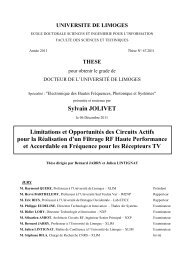Extraction, caractérisation chimique et valorisation biologique de ...
Extraction, caractérisation chimique et valorisation biologique de ...
Extraction, caractérisation chimique et valorisation biologique de ...
Create successful ePaper yourself
Turn your PDF publications into a flip-book with our unique Google optimized e-Paper software.
à 80°C par évaporation du méthanol chlorhydrique sous un flux d’azote. La phase<br />
méthanolique est délipidée par trois lavages successifs à l’heptane (3 x 1 mL). Elle est à<br />
nouveau évaporée sous flux d’azote.<br />
Triméthylsilylation<br />
Les méthylglycosi<strong>de</strong>s sont triméthylsilylés pendant 2 h à température ambiante par<br />
200 µL d’un mélange V/V pyridine/BSTFA (N,O-bis-triméthylsilyl-trifluoroacétami<strong>de</strong>) à 1 %<br />
<strong>de</strong> triméthylchlorosilane (TMCS) avant <strong>de</strong> pouvoir être injectés en CPG.<br />
III.2.6.b. Analyse <strong>de</strong>s dérivés TMS en CPG<br />
Les méthylglycosi<strong>de</strong>s triméthylsilylés sont ensuite i<strong>de</strong>ntifiés <strong>et</strong> dosés par CPG sur un<br />
chromatographe Perichrom PR-2100 en comparaison avec <strong>de</strong>s échantillons témoins.<br />
L'élévation <strong>de</strong> la température du four est programmée <strong>de</strong> 130 à 210°C à raison <strong>de</strong> 2°C.min -1 ,<br />
avec un palier <strong>de</strong> 5 min à 190°C, puis <strong>de</strong> 210 à 260°C à raison <strong>de</strong> 5°C.min -1 . Les résultats sont<br />
exprimés en pourcentage molaire après correction <strong>de</strong>s aires <strong>de</strong>s pics.<br />
III.2.7. Evaluation du taux d’acétylation <strong>et</strong> d’aci<strong>de</strong> 4-O-<br />
méthylglucuronique<br />
Le calcul <strong>de</strong> ces pourcentages a été effectué par utilisation <strong>de</strong> la RMN 1 H. Les spectres<br />
<strong>de</strong> RMN ont été réalisés sur un appareil Bruker DPX-400 à une fréquence <strong>de</strong> 400,13 MHz au<br />
Service commun <strong>de</strong> RMN <strong>de</strong> l’Université <strong>de</strong> Limoges. Les déplacements <strong>chimique</strong>s sont<br />
exprimés en ppm ; le t<strong>et</strong>raméthylsilane étant pris comme référence interne (δ = 0 ppm). Les<br />
spectres sont enregistrés dans l’eau <strong>de</strong>utériée. Les pourcentages ont été calculés selon la<br />
métho<strong>de</strong> décrite au paragraphe I.3.1.c (Prepière Partie) pour les différents xylanes testés.<br />
III.3. Autohydrolyse <strong>de</strong>s xylanes<br />
C<strong>et</strong>te métho<strong>de</strong> <strong>de</strong> fragmentation a été utilisée pour différents glucuronoxylanes <strong>de</strong><br />
châtaignier <strong>et</strong> d’argan.<br />
III.3.1. Protocole<br />
Le protocole utilisé a été adapté <strong>de</strong> Cescutti <strong>et</strong> al., 238 pour l'analyse d'un polysacchari<strong>de</strong><br />
aci<strong>de</strong>. Une solution aqueuse <strong>de</strong> polysacchari<strong>de</strong> à 1 mg.mL -1 est convertie en sa forme aci<strong>de</strong><br />
168
















